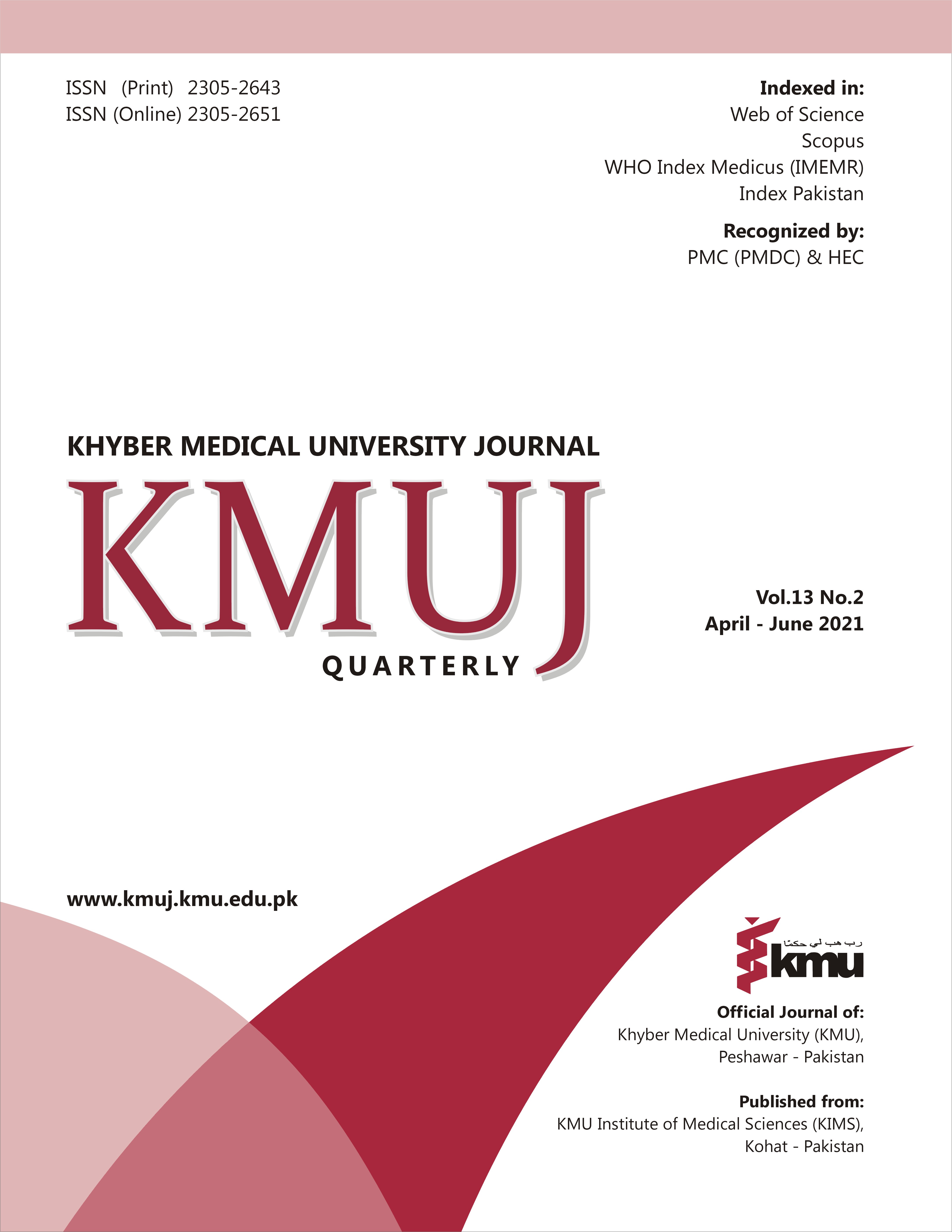OUTCOME OF ULTRASOUND GUIDED REDUCTION OF INTUSSUSCEPTION USING NORMAL SALINE: EXPERIENCE OF A TERTIARY CARE HOSPITAL OF PESHAWAR, PAKISTAN
Main Article Content
Abstract
OBJECTIVE: To determine the success rate of ultrasound guided hydrostatic reduction of intussusception using normal saline as an alternative to laparotomy.
METHODS: This prospective cross-sectional study was conducted at Pediatric Surgery department, Khyber Teaching Hospital, Peshawar from January-September 2018. Eighty patients aged between 3-24 months with clinical signs, symptoms and confirmatory sonographic evidence of intussusception were included in study. Procedure was carried out under ultrasound guidance using normal saline as medium for reduction. Maximum, three attempts were made each lasting 5-10 minutes.
RESULTS: Mean age of patients was 11.9±4.8 months. Majority (n=60/80; 75%) of patients were males. Thirty-five percent of patients (n=28/80) presented on second day followed by 32.5% (n=26/80) on first day. Mean time for presentation was 2.1±0.9 days. Most common type of intussusception was Ileo-colic (n=72/80; 90%). Overall success rate was 82.5% (n=66/88).
Success rate for patients presented within first day was 96.2% (n=25/26) as compared to 85.7% (n=24/28) in patients presented ≥1-2 days and 65.3% (17/26) in patients presented after two days. Reduction time of Intussusception ranged from 5-30 minutes with mean time of 17.5±1.4 minutes. In 76.3% (n=61/80) cases, intussusception was reduced within 20 minutes. In 14 (17.5%) patients, reduction could not be achieved (gangrenous gut=5, Meckel’s diverticulum=3, illeo-illeal intussusception=1, perforation=5). Recurrence rate of intussusception was 7.5% (n=6/80), including 4 (5%) cases within 24 hours and 2 (2.5%) cases within 2 months after reduction.
CONCLUSION: Ultrasound guided hydrostatic reduction of intussusception is an effective way to reduce intussusception, especially in patients presenting within two days.
Article Details
Work published in KMUJ is licensed under a
Creative Commons Attribution 4.0 License
Authors are permitted and encouraged to post their work online (e.g., in institutional repositories or on their website) prior to and during the submission process, as it can lead to productive exchanges, as well as earlier and greater citation of published work.
(e.g., in institutional repositories or on their website) prior to and during the submission process, as it can lead to productive exchanges, as well as earlier and greater citation of published work.
References
Cera SM. Intestinal intussusception. Clin Colon Rectal Surg 2008;21(2):106-13. https://doi.org/10.1055/s-2008-1075859.
Irish MS, Shellnut JK, Bovet PB. Pediatric Intussusception Surgery. Medscape Jun 30, 2017.
Ramsey KW, Halm BM. Diagnosis of intussusception using bedside ultrasound by a pediatric resident in the emergency department. Hawaii J Med Public Health 2014;73(2):58-60.
Xiang H, Han J, Ridley WE, Ridley LJ. Bull's-eye sign: various manifestations in the gastrointestinal tract. J Med Imaging Radiat Oncol 2018;62(1):60. https://doi.org/10.1111/1754-9485.08_12784.
Gluckman S, Karpelowsky J, Webster AC, McGee RG. Management for intussusception in children. Cochrane Database Syst Rev 2017;6(6):CD006476. https://doi.org/10.1002/14651858.CD006476.pub3.
Avci V, Agengin K, Bilici S. Ultrasound Guided Reduction of Intussusception with Saline and Evaluating the Factors Affecting the Success of the Procedure. Iran J Pediatr 2018;28(1):e62442. https://doi.org/10.5812/ijp.62442.
Ogundoyin OO, Olulana DI, Lawal TA. Childhood intussusception: A prospective study of management trend in a developing country. Afr J Paediatr Surg 2015;12(4):217-20. https://doi.org/10.4103/0189-6725.172541.
Bartocci M, Fabrizi G, Valente I, Manzoni C, Speca S, Bonomo L. Intussusception in childhood: role of sonography on diagnosis and treatment. J Ultrasound 2014;18(3):205-11. https://doi.org/10.1007/s40477-014-0110-9.
Khong PL, Peh WC, Lam CH, Chan KL, Cheng W, Lam WW, et al. Ultrasound-guided Hydrostatic Reduction of Childhood Intussusception: Technique and Demonstration. Radiographics 2000;20:5. https://doi.org/10.1148/radiographics.20.5.g00see11.
Mensah Y, Glover-Addy H, Etwire V, Appeadu-Mensah W, Twum M. Ultrasound guided hydrostatic reduction of intussusception in children at Korle Bu Teaching Hospital: an initial experience. Ghana Med J 2011;45(3):128-31.
Talabi AO, Famurewa OC, Bamigbola KT, Sowande OA, Afolabi BI, Adejuyigbe O. Sonographic guided hydrostatic saline enema reduction of childhood intussusception: a prospective study. BMC Emerg Med 2018;18(1):46. https://doi.org/10.1186/s12873-018-0196-z.
Lloyd DA, Kenny SE. The surgical abdomen. In: Pediatric Gastrointestinal Disease: Pathopsychology, Diagnosis, Management. Walker WA, Goulet O, Kleinman RE, et al (Eds). 4th ed. BC Decker, Ontario, 2004. pp. 604.
Jain S, Haydel MJ. Child Intussusception. [Updated 2020 Jul 17]. In: StatPearls [Internet]. Treasure Island (FL): StatPearls Publishing; 2021 Jan-. Accessed on: March 20, 2021. Available from URL: https://www.ncbi.nlm.nih.gov/books/NBK431078/
Lioubashevsky N, Hiller N, Rozovsky K, Segev L, Simanovsky N. Ileocolic versus Small-Bowel Intussusception in Children: Can US Enable Reliable Differentiation?. Radiology 2013;269(1):266-71. https://doi.org/10.1148/radiol.13122639.
Shekherdimian S, Lee SL. Management of pediatric intussusception in general hospitals: diagnosis, treatment, and differences based on age. World J Pediatr 2011;7(1):70-3.
Caruso AM, Pane A, Scanu A, Muscas A, Garau R, Caddeo F, et al. Intussusception in children: not only surgical treatment. J Pediatr Neonat Individ Med 2017;25:6(1):e060135. https://doi.org/10.7363/060135
Hsu WL, Lee HC, Yeung CY, Chan WT, Jiang CB, Sheu JC, et al. Recurrent Intussusception: when Should Surgical Intervention be performed? Pediatr Neonatol 2012;53(5):300-3. https://doi.org/10.1016/j.pedneo.2012.07.004.
Tander B, Baskin D, Candan M, Başak M, Bankoğlu M. Ultrasound guided reduction of intussusception with saline and comparison with operative treatment. Ulus Travma Acil Cerrahi Der 2007;13(4):288-93.
Bai YZ, Qu RB, Wang GD, Zhang KR, Li Y, Huang Y, et al. Ultrasound-guided hydrostatic reduction of intussusceptions by saline enema: a review of 5218 cases in 17 years. Am J Surg 2006;192(3):273-5. https://doi.org/10.1016/j.amjsurg.2006.04.013.
Ocal S, Cevik M, Boleken ME, Karakas E. A comparison of manual versus hydrostatic reduction in children with intussusception: Single-center experience. Afr J Paediatr Surg 2014;11:184-8. https://doi.org/10.4103/0189-6725.132834.
Xiaolong X, Yang W, Qi W, Yiyang Z, Bo X. Risk factors for failure of hydrostatic reduction of intussusception in pediatric patients: A retrospective study. Medicine (Baltimore) 2019;98(1):e13826. https://doi.org/10.1097/MD.0000000000013826.
Khorana J, Singhavejsakul J, Ukarapol N, Laohapensang M, Wakhanrittee J, Patumanond J. Enema reduction of intussusception: the success rate of hydrostatic and pneumatic reduction. Ther Clin Risk Manag 2015;11:1837-42. https://doi.org/10.2147/TCRM.S92169.
Sadigh G, Zou KH, Razavi SA, Khan R, Applegate KE. Meta-analysis of Air Versus Liquid Enema for Intussusception Reduction in Children. Am J Roentgenol 2015;205(5):542-9. https://doi.org/10.2214/AJR.14.14060.
Karadag CA, Abbasoglub L, Severa N, Kalyoncua MK, Yıldız A, Akim M, et al. Ultrasound-guided hydrostatic reduction of intussusception with saline: Safe and effective. J Pediatr Surg 2015;50(9):1563-5. https://doi.org/10.1016/j.jpedsurg.2015.03.046.
